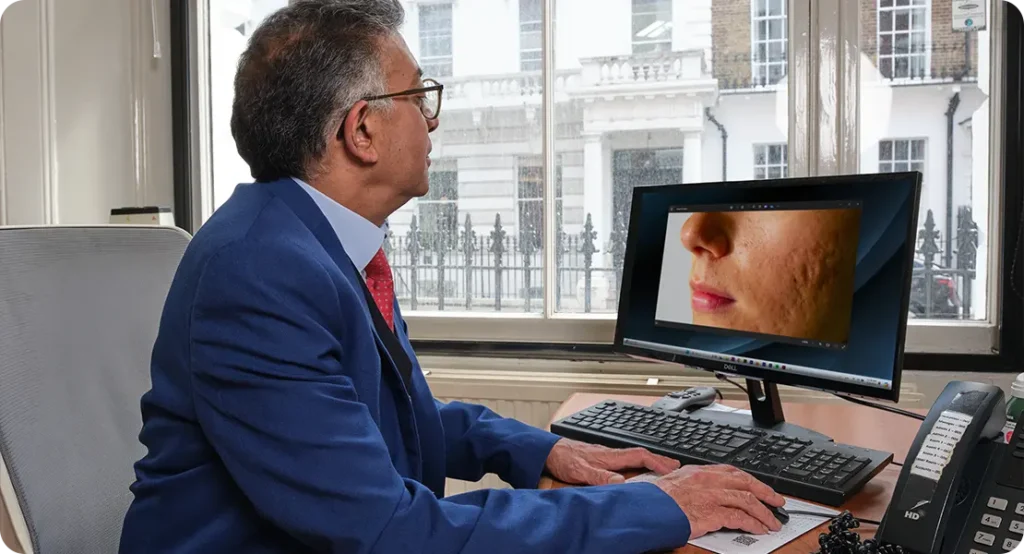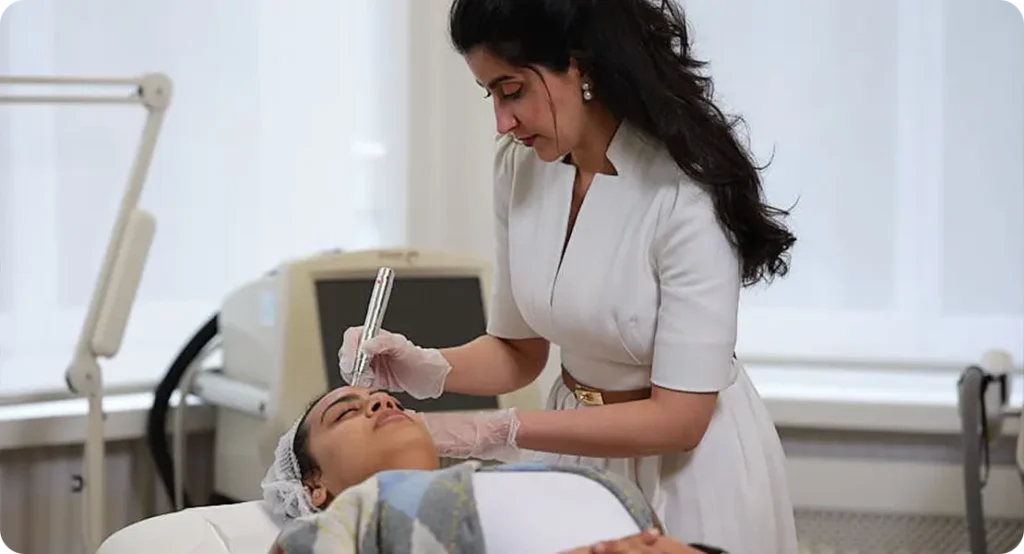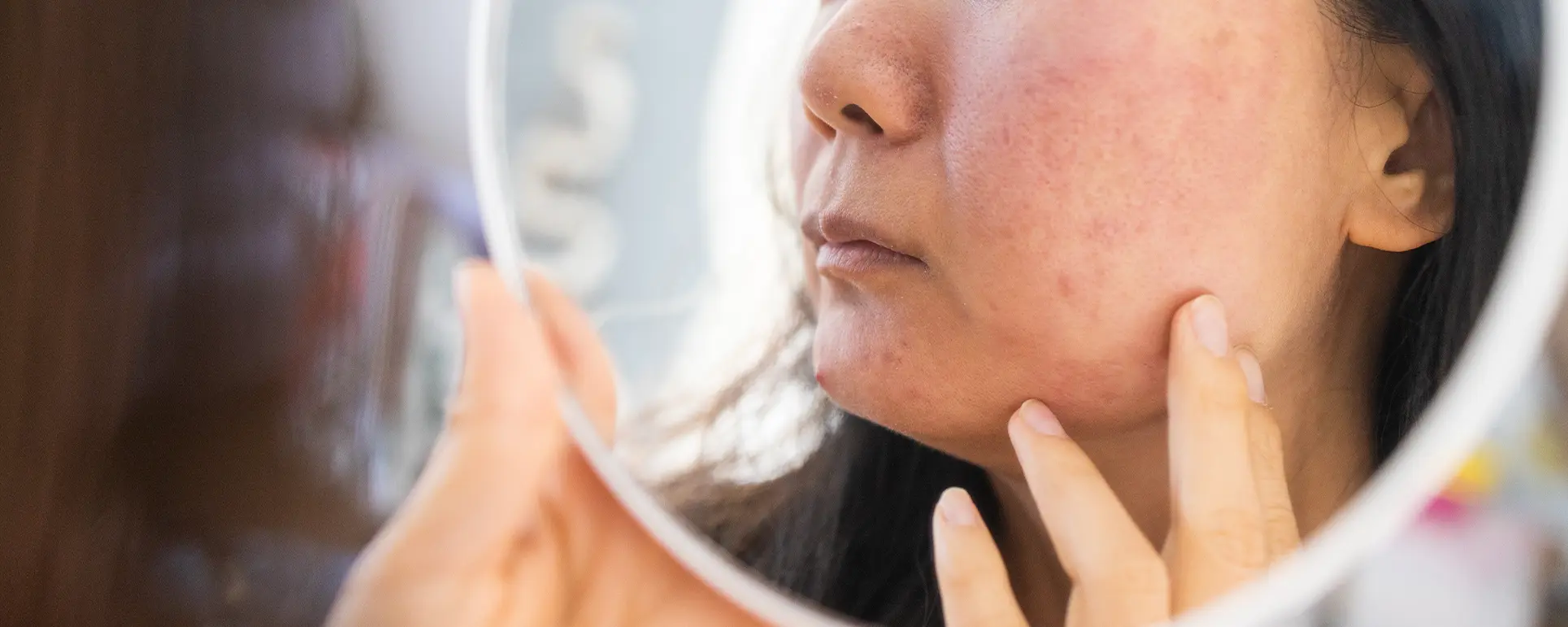If you’ve ever dealt with acne, you’ll know that the battle often doesn’t end once the active breakouts disappear. In many cases, they leave behind something just as frustrating skin discolouration that can linger for months or even years. These marks, often referred to as post-inflammatory hyperpigmentation (PIH) or post-inflammatory erythema (PIE), are the silent reminders of past spots. PIH appears as brown or dark patches on the skin, especially common in those with medium to darker skin tones, while PIE shows up as red or purplish marks, often more noticeable in lighter skin.
Although these marks aren’t permanent scars, they can still have a significant impact on your confidence. You might find yourself layering on concealer or avoiding close-up photos altogether. And while the skin does have a natural healing process, it’s not always fast and definitely not uniform for everyone.
The good news? You’re not stuck with these marks forever. With the right approach and a bit of patience, you can significantly fade or even completely eliminate them. Dermatologists now offer a range of effective treatments that target both the pigmentation and the inflammation behind these lingering spots. From topical ingredients like retinoids and niacinamide to professional procedures such as chemical peels and laser therapy, there are multiple options tailored to your skin type and needs.
In this article, we’ll take a closer look at what causes post-acne skin discolouration, how it differs from true acne scarring, what treatments dermatologists recommend to fade these marks, and some common mistakes to avoid if you’re treating them at home. Whether you’re dealing with stubborn dark spots or persistent redness, this guide will help you navigate your options and find the best path towards clearer, more even-toned skin.
What Causes Post-Acne Discolouration?
Even after a blemish has healed, your skin might not return to its usual tone right away. In fact, many people find that the after-effects of acne specifically discolouration can be even more frustrating than the breakouts themselves. So what’s really happening beneath the surface? When your skin experiences inflammation from acne, the healing process can sometimes trigger a pigmentary response or vascular changes, resulting in visible marks that linger for weeks, months, or even longer.
The two most common forms of discolouration that occur after acne are Post-Inflammatory Hyperpigmentation (PIH) and Post-Inflammatory Erythema (PIE). While they may look similar at first glance, they have different causes and require slightly different approaches to treatment.
1. Post-Inflammatory Hyperpigmentation (PIH)
Post-inflammatory hyperpigmentation is a response to trauma or inflammation in the skin such as a pimple, cyst, or even aggressive squeezing that causes melanocytes (pigment-producing cells) to ramp up melanin production. The result is flat, darkened spots that can appear brown, black, or purple depending on your natural skin tone.
PIH is particularly common in people with medium to darker skin tones because their melanocytes are more reactive. However, it can affect anyone regardless of skin colour. These pigmented spots often become more noticeable with sun exposure, which can make them even darker and prolong the fading process.
Unlike true scars, PIH doesn’t involve a change in skin texture meaning the skin is still smooth to the touch but the discolouration can still be distressing. Left untreated, these marks can fade on their own over time, but the process is slow and can take several months or even a year.
2. Post-Inflammatory Erythema (PIE)
Post-inflammatory erythema, on the other hand, appears as red, pink, or purplish patches that remain after an acne lesion has healed. This type of discolouration is caused by damage to the small blood vessels (capillaries) near the surface of the skin during inflammation. Unlike PIH, PIE is not a pigment issue but a vascular one.
PIE is most commonly seen in individuals with lighter or fair skin tones, although it can occur in other skin types as well. These marks are often mistaken for active acne or persistent redness, but they’re actually the result of the body’s inflammatory response and take time to resolve.
Since PIE is related to blood vessels rather than pigment, it doesn’t respond well to traditional pigmentation treatments like brightening serums or exfoliants. Instead, it often requires treatments that target vascular concerns such as pulsed dye laser (PDL) or IPL (intense pulsed light) to reduce the visible redness.
Why These Marks Stick Around
Both PIH and PIE can linger long after the acne has cleared. There are several reasons why these marks may persist:
- Sun exposure: Ultraviolet (UV) rays can worsen both PIH and PIE. UV rays stimulate melanin production, deepening hyperpigmented spots, and can aggravate vascular inflammation, intensifying redness.
- Picking or popping pimples: Manually interfering with acne lesions increases inflammation and the risk of skin trauma, both of which make PIH and PIE more likely to occur and more stubborn to fade.
- Lack of proper aftercare: Not using SPF, skipping moisturiser, or over-exfoliating can all interfere with the skin’s natural healing process and delay recovery from post-acne marks.
- Genetics and skin tone: Some people are simply more prone to pigmentation or vascular damage after inflammation due to genetic factors.
Understanding whether you’re dealing with PIH, PIE, or a combination of both is the first step in selecting the right treatments. While the two conditions can overlap and sometimes co-exist in the same spot, identifying the underlying cause of your discolouration will help you choose a more effective skincare strategy and avoid making it worse.
Dermatological Treatments for Post-Acne Discolouration

If your post-acne marks aren’t fading with over-the-counter serums or home remedies, it may be time to consider professional treatments. While topical skincare can help in mild to moderate cases, dermatological interventions often offer faster and more dramatic results especially for stubborn or long-standing pigmentation and redness.
Dermatologists are trained to distinguish between PIH and PIE and can recommend treatments tailored to your skin type, tone, and sensitivity. Here’s a breakdown of the most effective in-office options that target post-acne discolouration:
1. Topical Prescription Treatments
Topical therapies remain a first-line approach, especially when used under the guidance of a dermatologist. Prescription-strength products tend to be more potent than those available in stores and can work synergistically with other treatments.
Hydroquinone:
One of the most widely used ingredients for PIH, hydroquinone works by inhibiting tyrosinase, an enzyme involved in melanin production. Applied over time, it gradually lightens dark spots. However, long-term use must be monitored by a dermatologist to prevent side effects like skin irritation or rebound pigmentation.
Retinoids (Retinol, Tretinoin, Adapalene):
These vitamin A derivatives speed up skin cell turnover, helping to fade both red and brown marks. They also stimulate collagen production, which can improve skin texture and tone over time. Retinoids are particularly effective when combined with other treatments, though they can cause dryness or peeling initially.
Niacinamide:
This multi-tasking antioxidant reduces inflammation, regulates oil production, and helps lighten hyperpigmentation. It’s gentle enough for sensitive skin and is often used alongside exfoliating acids or retinoids for enhanced results.
Vitamin C (Ascorbic Acid):
A powerful antioxidant that brightens skin by reducing melanin synthesis and neutralising free radicals. It also helps protect skin from further sun damage, which can worsen discolouration. Consistency is key, as results typically show after several weeks of regular use.
Alpha Hydroxy Acids (AHAs):
Ingredients like glycolic acid, lactic acid, and mandelic acid exfoliate the surface of the skin, promoting the removal of pigmented cells. AHAs are particularly helpful for uneven tone, dullness, and texture concerns, making them a good choice for patients dealing with both PIH and mild acne scarring.
Azelaic Acid and Kojic Acid (optional additions):
Azelaic acid helps reduce inflammation and pigmentation and is particularly suitable for rosacea-prone skin. Kojic acid works similarly to hydroquinone but is gentler, making it a good alternative for long-term maintenance.
2. Chemical Peels
For more noticeable pigmentation or redness, chemical peels offer a more intensive approach. In this treatment, a dermatologist applies a chemical solution to the skin, which exfoliates the upper layers and triggers regeneration. As dead skin cells slough off, fresh, more evenly toned skin is revealed beneath.
Peels are typically done in a series and can range from superficial to deep, depending on the skin issue being treated.
Common chemical peel ingredients include:
- Glycolic Acid: Penetrates deeply to exfoliate and improve skin texture, tone, and pigmentation.
- Salicylic Acid: Ideal for acne-prone skin; reduces redness and clears pores while also helping with PIE.
- Lactic Acid: A gentler AHA suitable for sensitive skin types and early-stage pigmentation.
For best results, chemical peels may be combined with topical treatments to maintain progress between sessions. It’s important to follow aftercare instructions strictly especially using sun protection to prevent post-treatment sensitivity or further pigmentation.
3. Laser and Light-Based Treatments
When pigmentation runs deep or is resistant to topical treatments, laser therapy is one of the most effective options available. Laser treatments target either excess pigment or damaged blood vessels, depending on whether you’re treating PIH or PIE.
Fractional CO2 Laser:
This ablative laser treatment works by creating micro-injuries in the skin to stimulate collagen production and accelerate cellular turnover. It’s highly effective for both post-acne pigmentation and textural scarring, though recovery time can be longer due to redness and peeling.
PicoSure Laser:
A non-ablative laser that breaks down excess pigment into tiny particles, which are then cleared away by the body’s natural processes. PicoSure is gentler than fractional lasers and is suitable for darker skin tones, where the risk of post-treatment hyperpigmentation is higher.
Vascular Lasers (e.g. Pulsed Dye Laser or IPL):
These are specifically designed to treat PIE by targeting dilated blood vessels beneath the skin. They reduce redness, flushness, and visible capillaries without affecting the surrounding tissue. Over a few sessions, vascular lasers can significantly improve skin tone and reduce the appearance of red marks.
4. Microneedling (Optional Addition)

Though not a laser, microneedling is worth mentioning as an adjunct treatment for post-acne discolouration. This involves creating tiny punctures in the skin using fine needles, which stimulates the production of collagen and elastin. When paired with topical serums (like vitamin C or growth factors), microneedling can improve both pigmentation and texture with minimal downtime.
Why Professional Treatment Matters
One of the biggest advantages of seeing a dermatologist is personalisation. Your provider can assess your skin type, identify whether your marks are due to PIH, PIE, or scarring, and build a tailored plan that combines different treatments for optimal results. In many cases, a multi-pronged approach yields faster and more sustained improvement than using a single method alone.
Professional treatments may also help prevent worsening pigmentation caused by inappropriate product use, sun exposure, or untreated acne. Most importantly, they offer medical-grade solutions that go beyond what’s available on high-street shelves.
What to Avoid When Dealing with Post-Acne Discolouration
Treating post-acne discolouration requires a delicate balance of effective care and patience. While it’s tempting to try every product or remedy you come across, certain habits and skincare mistakes can actually make your skin worse or significantly slow down your progress. Here are the most important things to avoid if you’re trying to fade hyperpigmentation (PIH) or erythema (PIE):
1. Picking, Squeezing, or Touching Your Skin
It may be tempting to squeeze a spot or pick at a healing blemish, especially when it’s raised or scabbed. But this is one of the worst things you can do if you’re trying to avoid long-lasting marks. Picking at acne increases inflammation, causes micro-tears in the skin, and can lead to infection all of which raise your chances of developing post-inflammatory hyperpigmentation or red scarring.
Even seemingly harmless habits like rubbing your face, resting your chin on your hand, or scratching healing lesions can contribute to worsening discolouration. The skin needs time to heal undisturbed, so hands-off is always the best policy.
2. Skipping Sunscreen Even on Cloudy Days
Sun exposure is a major contributor to both the development and persistence of post-acne marks. Ultraviolet (UV) rays stimulate melanin production in the skin, which can darken existing pigmentation (PIH) and make red marks (PIE) more visible. Even short periods of unprotected sun exposure can undo weeks of progress in fading these marks.
Daily use of a broad-spectrum sunscreen with SPF 30 or higher is non-negotiable. Apply it every morning, and reapply every two hours if you’re outdoors. Look for sunscreens that are labelled as non-comedogenic and formulated for sensitive or acne-prone skin to avoid clogged pores or irritation. Physical (mineral) sunscreens with zinc oxide or titanium dioxide are often gentler and better tolerated by reactive skin.
3. Using Harsh or Drying Products
It’s easy to fall into the trap of using strong, alcohol-heavy toners or astringents in an attempt to clear up breakouts quickly. Unfortunately, many of these products strip the skin of its natural oils, disrupt the skin barrier, and lead to increased dryness and inflammation. This can delay the healing process and worsen both redness and pigmentation.
Ingredients to avoid (or use with caution) include:
- Denatured alcohol
- Fragrance (especially in high concentrations)
- Harsh scrubs with large or irregular particles (like walnut shell)
- Overly acidic formulations not suited to your skin’s pH
Instead, aim for soothing, hydrating products that support your skin’s barrier function like those containing ceramides, panthenol, or hyaluronic acid. Keeping your skin calm and well-moisturised is essential for healing discolouration effectively.
4. Over-Exfoliating Your Skin
Exfoliation helps remove dead skin cells and can accelerate the fading of discolouration when used correctly. However, more exfoliation doesn’t mean better or faster results. Over-exfoliating whether through physical scrubs or chemical exfoliants can damage the skin barrier, cause irritation, and trigger inflammation, which may actually worsen PIH and PIE.
If you’re already using active ingredients like retinoids, AHAs, or BHAs, be cautious about layering or doubling up on exfoliants. Too many active treatments at once can lead to a cycle of irritation, redness, and slow recovery. Most dermatologists recommend chemical exfoliation no more than 2–3 times a week, depending on your skin type.
Signs you’re overdoing it include:
- Increased sensitivity or burning sensations
- Flaking or peeling skin
- Persistent redness
- Small bumps or breakouts resembling irritation
5. Impatient Product Switching
It can be discouraging when a product doesn’t deliver results right away, but constantly switching between treatments can prevent your skin from adjusting and worsen irritation. Most topical treatments for discolouration take at least 6 to 12 weeks of consistent use to show noticeable results. Changing your routine too frequently or layering incompatible ingredients can backfire.
Stick to a simple, consistent routine with proven actives like niacinamide, retinoids, or vitamin C. Introduce new products one at a time, and give your skin time to respond before adding something else.
6. Ignoring Underlying Acne
Focusing only on fading discolouration without addressing active breakouts can be counterproductive. As new pimples form and heal, they can leave behind additional marks leading to an ongoing cycle of pigmentation. If you’re still breaking out regularly, work with a dermatologist to get your acne under control first, then shift your focus to treating the residual discolouration.
Final Thought: Brighter Skin Is Possible with the Right Care
Dealing with post-acne discolouration can be frustrating, but with the right treatments, you can significantly improve the appearance of your skin. Whether you’re dealing with hyperpigmentation or redness, a dermatologist in London can guide you through the best treatments for your skin type and help you achieve clearer, more even-toned skin.
You can get in touch with us to book a consultation with our acne clinic in London. We offer professional treatments tailored to your skin type and concerns, helping you fade marks safely and effectively.
References:
- Navarrete‑Solís, A. M. et al. (2011) ‘A double‑blind, randomized clinical trial of niacinamide 4 % versus hydroquinone 4 % in the treatment of melasma’, Dermatology Research and Practice, vol. 2011, Article ID 379173. Available at: https://onlinelibrary.wiley.com/doi/full/10.1155/2011/379173
- Ambros‑Ripoll, I., Fabbrocini, G. and Haddad, J. (2021) ‘Treatment protocols and efficacy of light and laser treatments in post‑acne erythema’, Austalasian Journal of Dermatology, in PubMed (online). Available at: https://pubmed.ncbi.nlm.nih.gov/34985175
- Park, K. Y., Ko, E. J., Seo, S. J. and Hong, C. K. (2024) ‘Treatment of erythematous acne scars using 595‑nm pulsed dye laser combined with 1565‑nm nonablative fractional laser’, Journal of Cosmetic Dermatology, Wiley Periodicals LLC. Available at: https://pubmed.ncbi.nlm.nih.gov/38426374
- Garg, V. K. and Hengge, U. R. (2020) ‘Evidence‑based surgical management of post‑acne scars’, Journal of Cutaneous and Aesthetic Surgery, vol. 13, no. 2, pp. 99–111. Available at: https://journals.lww.com/JCAS/Fulltext/2020/13020/Evidence_based_Surgical_Management_of_Post_acne.5.aspx
- Thaçi, D. and Thera, R. (2025) ‘Prevention of post‑inflammatory hyperpigmentation in skin of colour: a systematic review’, Australasian Journal of Dermatology, first published April 2025. Available at: https://pubmed.ncbi.nlm.nih.gov/39953770
